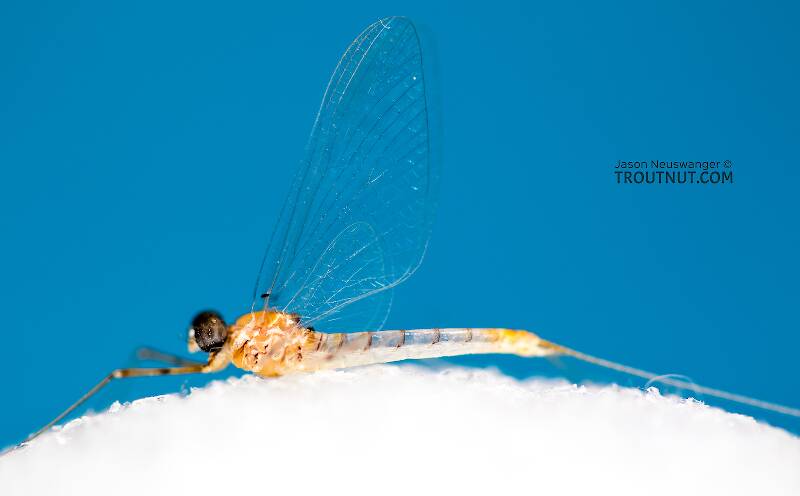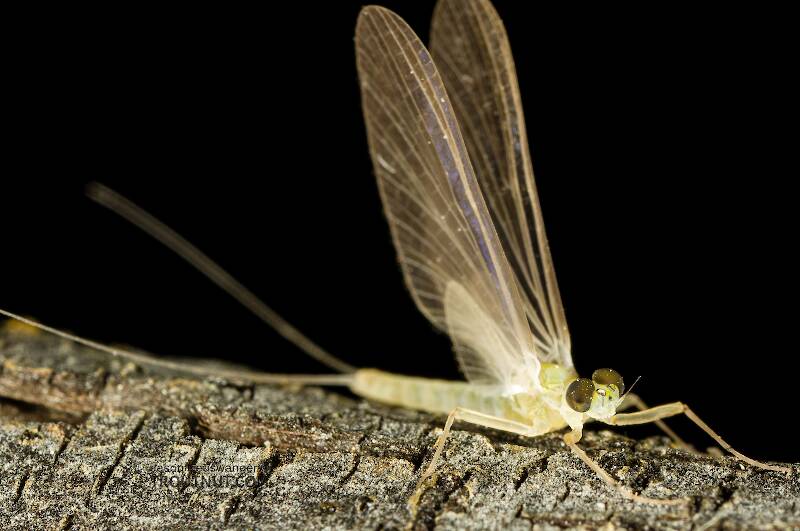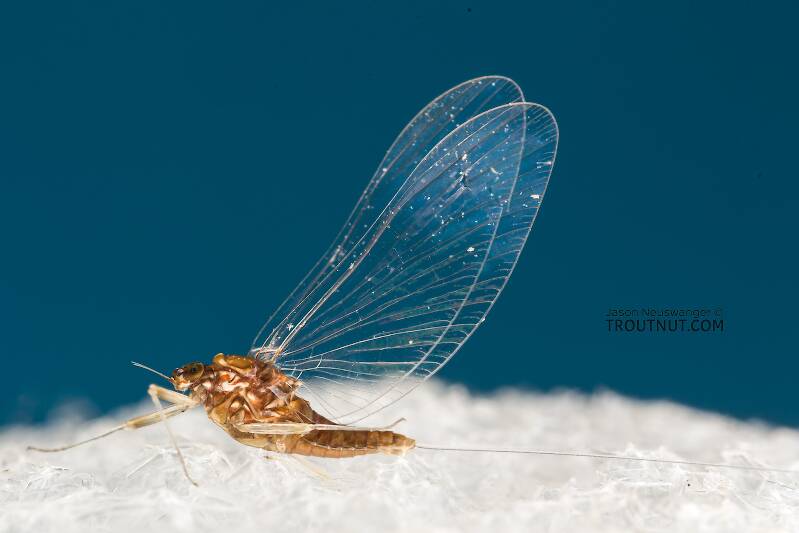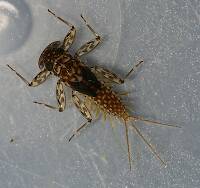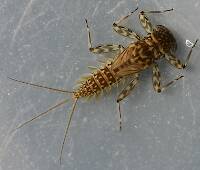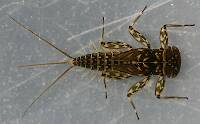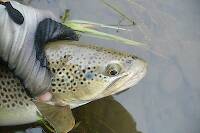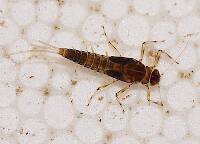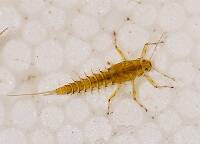
Salmonflies
Pteronarcys californica
The giant Salmonflies of the Western mountains are legendary for their proclivity to elicit consistent dry-fly action and ferocious strikes.
Featured on the forum

This is the first of it's family I've seen, collected from a tiny, fishless stream in the Cascades. The three species of this genus all live in the Northwest and are predators that primarily eat stonefly nymphs Merritt R.W., Cummins, K.W., and Berg, M.B. (2019).

Troutnut is a project started in 2003 by salmonid ecologist Jason "Troutnut" Neuswanger to help anglers and
fly tyers unabashedly embrace the entomological side of the sport. Learn more about Troutnut or
support the project for an enhanced experience here.
This topic is about the Insect Order Ephemeroptera
Mayflies may be the most important insects for trout anglers to understand. They are an ancient order of insects, famous outside the fly-fishing world for their fragile beauty and short adult lifespan, often a single day to mate and die. The mayfly's poignant drama attracts poets and anglers alike, but anglers make the most of it.Mayflies live more than 99% of their lives as nymphs on the river or lake bottom, filling many crucial roles in freshwater ecosystems as they feed and grow. They eventually emerge from the water as winged sub-adults called "subimagos" by scientists and "duns" by anglers. Duns evolved to be good at escaping the water, with a hydrophobic surface and hardy build, but they are clumsy fliers. Within a day or two they molt one last time into "imagos" or "spinners," the mature adults, a transformation captured in this photo series of a dun molting into a spinner. They have longer legs and tails, and sleeker, more lightweight bodies, giving them the airborne speed, agility, and long grasp they need for their midair mating rituals. They are usually darker than the duns and have shinier, more transparent wings. They die within minutes or hours after mating.
Example specimens
Troutnabout
Posts: 20
Posts: 20
Troutnabout on Sep 16, 2006September 16th, 2006, 3:52 pm EDT
Jason: When do claspers appear on male species?
Troutnut on Sep 16, 2006September 16th, 2006, 4:15 pm EDT
Good question. They're present in pretty much their final form in the duns, and of course the spinners have them.
I've seen them starting to show on some mature nymphs, I think. The pictures should be somewhere on this site, but I don't remember which specimens. They aren't generally visible on most nymphs, so I'm guessing they start to appear in the last few nymphal instars and don't become really prominent until the dun stage.
I've seen them starting to show on some mature nymphs, I think. The pictures should be somewhere on this site, but I don't remember which specimens. They aren't generally visible on most nymphs, so I'm guessing they start to appear in the last few nymphal instars and don't become really prominent until the dun stage.
Jason Neuswanger, Ph.D.
Troutnut and salmonid ecologist
Troutnut and salmonid ecologist
Troutnabout
Posts: 20
Posts: 20
Troutnabout on Sep 16, 2006September 16th, 2006, 4:46 pm EDT
Thanks Jason. Are there any gender distinguishing characteristcs during the nymphal stage?
GONZO on Sep 17, 2006September 17th, 2006, 4:24 am EDT
Jason is right that the claspers can be seen on mature nymphs. In addition, slight differences in overall size and the size of the eyes can be gender clues with many mayfly nymphs (some color and marking differences can also be noted, but you must be very familiar with the species). So, within a mature population of an Ephemerella species, the smaller, sometimes darker, large-eyed nymphs with claspers are males.
One practical application of this information with regard to Ephemerellidae is that the males typically mature first (dark wingcases). In the early part of a hatching period, males will predominate. With species like the Hendriksons, which often display significant gender differences in size and color among adults, this can be an important trait when fishing over fussy, hard-fished trout.
One practical application of this information with regard to Ephemerellidae is that the males typically mature first (dark wingcases). In the early part of a hatching period, males will predominate. With species like the Hendriksons, which often display significant gender differences in size and color among adults, this can be an important trait when fishing over fussy, hard-fished trout.
Troutnut on Sep 17, 2006September 17th, 2006, 8:23 am EDT
Thanks Gonzo... that reminds me, somewhere one of my nymph pictures shows those developing eyes in a male nymph pretty well. Again I'm not sure which one, unfortunately.
Figuring out nymph gender would be a great topic for a feature article on this site. I'll have to ask some entomologists about more failsafe ways to do it (if there are any) for earlier nymphs. I bet a dissection knife and microscope are required for many of them.
This brings to mind one thing I've always wondered about. Many of the Ephemerella nymphs come in several different color schemes in each river. This is especially true in E. subvaria, the Hendricksons. Since the male and female adults are usually different colors, I wonder if the same is true in the nymphs. Are some of the colors only for males, and others only for females? This question probably isn't too hard to answer...
Figuring out nymph gender would be a great topic for a feature article on this site. I'll have to ask some entomologists about more failsafe ways to do it (if there are any) for earlier nymphs. I bet a dissection knife and microscope are required for many of them.
This brings to mind one thing I've always wondered about. Many of the Ephemerella nymphs come in several different color schemes in each river. This is especially true in E. subvaria, the Hendricksons. Since the male and female adults are usually different colors, I wonder if the same is true in the nymphs. Are some of the colors only for males, and others only for females? This question probably isn't too hard to answer...
Jason Neuswanger, Ph.D.
Troutnut and salmonid ecologist
Troutnut and salmonid ecologist
Troutnabout
Posts: 20
Posts: 20
Troutnabout on Sep 17, 2006September 17th, 2006, 1:40 pm EDT
Thanks Guys! I'm taking an entemology study later this week. I'll tryout some of your suggestions when looking at nymphs. Maybe I'll get some pics too.
GONZO on Sep 17, 2006September 17th, 2006, 5:36 pm EDT
That's a good question, Jason. In the Yellow Breeches, Sulphur nymphs (E. invaria) have four color variations--nearly black, brown, olive, and amber. All four colors can often be found occupying the same rock. My guess is that these variations have evolved so that a certain percentage of the population will be more or less camouflaged against various backgrounds (which seems to fit with invaria's adaptability to diverse habitats). I don't think these colors are gender-specific, however. If they were, one would expect that all of the black or brown ones would be males, and all of the olive and amber would be female. This does not seem to be the case. I suspect it is more likely that you might detect gender differences within a color group (dark olive vs. light olive), but I'm not sure.
What I can say with regard to Hendriksons, however, is that you can sometimes see gender clues in the belly color of mature nymphs. On the Brodheads, female Hendrikson duns often have pink bellies. I have found fully mature female nymphs (some of which were quite dark in dorsal coloration) that displayed pink bellies.
Other families offer other gender clues as nymphs:
In the Polymitarcyidae, male White Fly nymphs (Ephoron spp.) have a shorter center tail (which they lose). Females, which mate as duns, have three short tails (which they retain).
Among the Ephemeridae, male Yellow Drake nymphs (Ephemera varia), in addition to being smaller and having larger eyes, have a slightly different pattern of dorsal (tergite) markings than females.
Because both groups of nymphs (White Flies and Yellow Drakes) are pale and rather translucent, the color of the developing eggs will impart a yellowish cast to the abdomen of fully mature female nymphs.
Of course, all of these distinctions are for mature nymphs. As for detecting gender differences in earlier instars, I haven't a clue!
What I can say with regard to Hendriksons, however, is that you can sometimes see gender clues in the belly color of mature nymphs. On the Brodheads, female Hendrikson duns often have pink bellies. I have found fully mature female nymphs (some of which were quite dark in dorsal coloration) that displayed pink bellies.
Other families offer other gender clues as nymphs:
In the Polymitarcyidae, male White Fly nymphs (Ephoron spp.) have a shorter center tail (which they lose). Females, which mate as duns, have three short tails (which they retain).
Among the Ephemeridae, male Yellow Drake nymphs (Ephemera varia), in addition to being smaller and having larger eyes, have a slightly different pattern of dorsal (tergite) markings than females.
Because both groups of nymphs (White Flies and Yellow Drakes) are pale and rather translucent, the color of the developing eggs will impart a yellowish cast to the abdomen of fully mature female nymphs.
Of course, all of these distinctions are for mature nymphs. As for detecting gender differences in earlier instars, I haven't a clue!
Troutnut on Sep 18, 2006September 18th, 2006, 6:53 am EDT
Thanks! You've listed several interesting characteristics I didn't know yet.
Jason Neuswanger, Ph.D.
Troutnut and salmonid ecologist
Troutnut and salmonid ecologist
Quick Reply
Related Discussions
Topic
Replies
Last Reply
4
Sep 27, 2014
by Millcreek
by Millcreek
1
Sep 9, 2008
by GONZO
by GONZO
4
Sep 4, 2012
by Entoman
by Entoman


